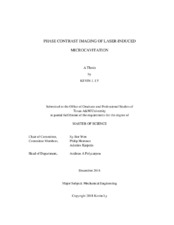Phase Contrast Imaging of Laser-Induced Microcavitation
Abstract
As the medical field becomes more advanced, the scale of operation becomes increasingly smaller. Due to this trend, traditional mechanical tools like a scalpel may not become fine enough to be used for such manipulation. As a result, laser based medical surgeries such as LASIK (Laser assisted in situ keratomileusis) have become popular in recent decades. The associated laser tissue interactions, in particular photoablation, have become an important field of study to reduce unpredictable aftereffects of laser surgery. A consequence of photoablation is laser-induced microcavitation. Laser – induced microcavitation is a process in which optical energy from a laser converts to thermal energy of the tissue and creates a shockwave and a vapor bubble inside a liquid rich environment. As most bio-tissue is liquid rich, laser-induced microcavitation is an important field to study. There have been a number of theoretical and experimental studies regarding laser-induced microcavitation. However most theoretical studies are semi-analytical and focus on the oscillation of the cavitation bubble after it has formed. Additionally, most visual experimental studies use brightfield microscopy to image the microcavitation process. In order to supplement the existing theoretical and experimental studies, this thesis will develop a thermodynamic numerical simulation for the early (< 1 μs) microcavitation process and an experimental setup to image microcavitation develop with phase contrast microscopy. The goal of the numerical simulation is to accurately model the microcavitation process. The corresponding goal of the experimental setup is to identify additional features not visible in brightfield microscopy. The numerical simulation developed in this study was able to model the bubble and shockwave features, but still needs refinement due to only considering linear light absorption instead of plasma induced ablation. The pulsed illumination phase contrast microscopy developed in this study was able to image the vapor bubble boundary with higher contrast and resolve additional features in the high pressure region between the bubble and shockwave. As phase contrast microscopy is a qualitative imaging rather than a quantitative imaging process, the next step is to use differential interference contrast (DIC) microscopy to quantify the features resolved in phase contrast microscopy.
Citation
Ly, Kevin J (2018). Phase Contrast Imaging of Laser-Induced Microcavitation. Master's thesis, Texas A&M University. Available electronically from https : / /hdl .handle .net /1969 .1 /192061.


